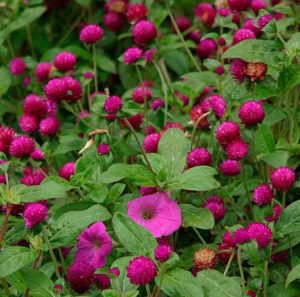 Scientific name: Gomphrena globosa
Scientific name: Gomphrena globosa
Usage
In Hawaii, it is commonly used in long-lasting leis since it retains its shape and colour after drying. In Nepal, the flower is commonly known as “Supari Ful” and is used to make a garland during Bhai Tika, which is the last day of Tihar. The garland is put around the boy’s neck by his sister for protection.
This plant is popular in landscape designs and gardening for its vivid colours and colour retention.
The edible plant G. globosa has been used in herbal medicine. In Trinidad, the flowers are boiled to make tea, which is used for baby gripe, oliguria, cough and diabetes.[5] Caribbean folk medicine historically used globe amaranth to relieve prostate and reproductive problems.[6] The purple inflorescences have been used as a remedy for several respiratory inflammation conditions including bronchial asthma, acute and chronic bronchitis, and whooping cough.[3] Recommended uses in traditional medicine range from the treatment of respiratory diseases, jaundice, urinary system conditions, and kidney problems.[2] Manuscripts dating back to the 1870s ascribe beneficial properties to Gomphrena roots, specifically for digestive and respiratory tract issues as well as the ability to act as a stimulant.[7]
The flowers of G. globosa are rich in betacyanins, which have a wide range of applications as additives and supplements in the food industry, cosmetics, and livestock feed. Stable between pH 3 and 7, the betacyanins in globe amaranth are suitable to be used as natural food dye and as they produce a red-violet colour.[8]
Additionally, betacyanins have displayed interesting medicinal characteristics as powerful antioxidant and chemo preventive compounds in both in vitro and in vivo models. G. globosa inflorescences extract decreased nitric oxide content in cultured macrophages (Mendes, 1986).
Country of Origin
G. globosa is native to Central America including regions of Brazil, Panama, and Guatemala, but is now grown globally (Roriz, 2017).
Time to harvest
Seeds ripen about 3 months after planting, usually in the mid- to late summer, depending on the climate when they are planted. They are ready to harvest when they begin to fall from the flower head (tassel) (Grant A. , 2019).
Share with:

